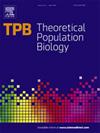Importance of environmental productivity and diet quality in intraguild predation
IF 1.3
4区 生物学
Q4 ECOLOGY
引用次数: 0
Abstract
In the intricate network of ecological interactions, intraguild predation emerges as a fundamental community module incorporating omnivory. Classical equilibrium theory predicts the exclusion of the intraguild predator and prey at low and high environmental productivity, respectively, with the coexistence of both species occurring only at intermediate productivity levels. However, empirical studies challenge this theoretical prediction, particularly concerning the extinction of intraguild prey in highly productive environments. To address this enigmatic issue, Diehl (2003), Abrams and Fung (2010a) explore the impact of food quality and propose that low nutritional quality of the basal resource stabilizes omnivorous systems. Yet, the influence of intermediate consumer quality remains inadequately explored. This study employs analytical and numerical bifurcation studies to investigate the effects of the quality of two diet types. Various bifurcations, including supercritical and subcritical Hopf bifurcations, saddle-node bifurcations of periodic solutions, and transcritical bifurcations of periodic solutions are observed. These bifurcations are directly linked to the destinies of intraguild prey and predators. The results reveal that, in highly productive environments, it may not be the intermediate consumer but the omnivore that faces extinction. This discovery holds significant implications for the conservation and management of omnivorous systems.

环境生产力和饲料质量在野生捕食中的重要性。
在错综复杂的生态相互作用网络中,野生动物捕食作为一个基本的融合杂食的群落模块出现。经典平衡理论预测,在低环境生产力和高环境生产力条件下,捕食者和被捕食者将分别被排除在外,而两种物种仅在中等环境生产力水平下共存。然而,实证研究对这一理论预测提出了挑战,特别是关于高产环境中野生猎物的灭绝。为了解决这个谜一样的问题,Diehl(2003)和Abrams and Fung (2010a)探讨了食物质量的影响,并提出基础资源的低营养质量可以稳定杂食性系统。然而,中间消费者素质的影响仍未得到充分探讨。本研究采用分析分岔法和数值分岔法研究了两种日粮对肉鸡品质的影响。观察到各种分岔,包括超临界和亚临界Hopf分岔、周期解的鞍节点分岔和周期解的跨临界分岔。这些分化直接关系到野生猎物和捕食者的命运。研究结果表明,在高产的环境中,面临灭绝的可能不是中间消费者,而是杂食动物。这一发现对杂食性系统的保护和管理具有重要意义。
本文章由计算机程序翻译,如有差异,请以英文原文为准。
求助全文
约1分钟内获得全文
求助全文
来源期刊

Theoretical Population Biology
生物-进化生物学
CiteScore
2.50
自引率
14.30%
发文量
43
审稿时长
6-12 weeks
期刊介绍:
An interdisciplinary journal, Theoretical Population Biology presents articles on theoretical aspects of the biology of populations, particularly in the areas of demography, ecology, epidemiology, evolution, and genetics. Emphasis is on the development of mathematical theory and models that enhance the understanding of biological phenomena.
Articles highlight the motivation and significance of the work for advancing progress in biology, relying on a substantial mathematical effort to obtain biological insight. The journal also presents empirical results and computational and statistical methods directly impinging on theoretical problems in population biology.
 求助内容:
求助内容: 应助结果提醒方式:
应助结果提醒方式:


